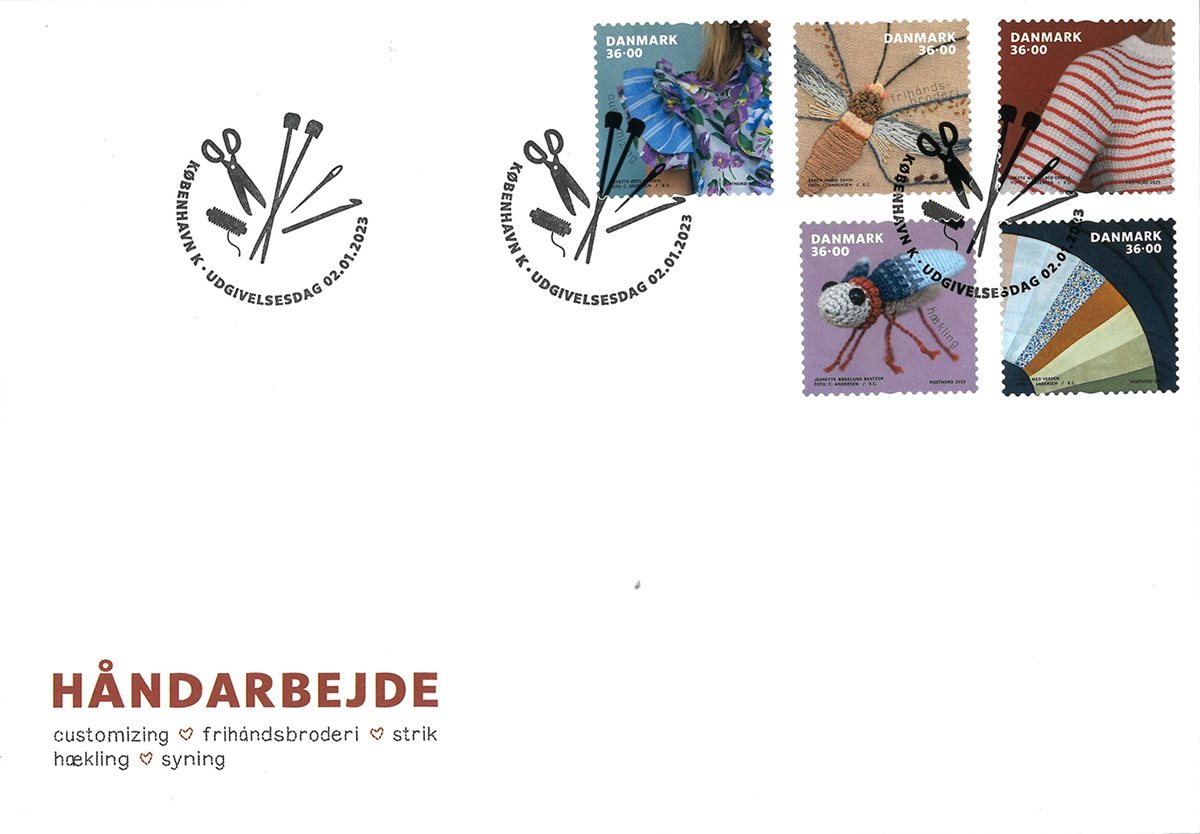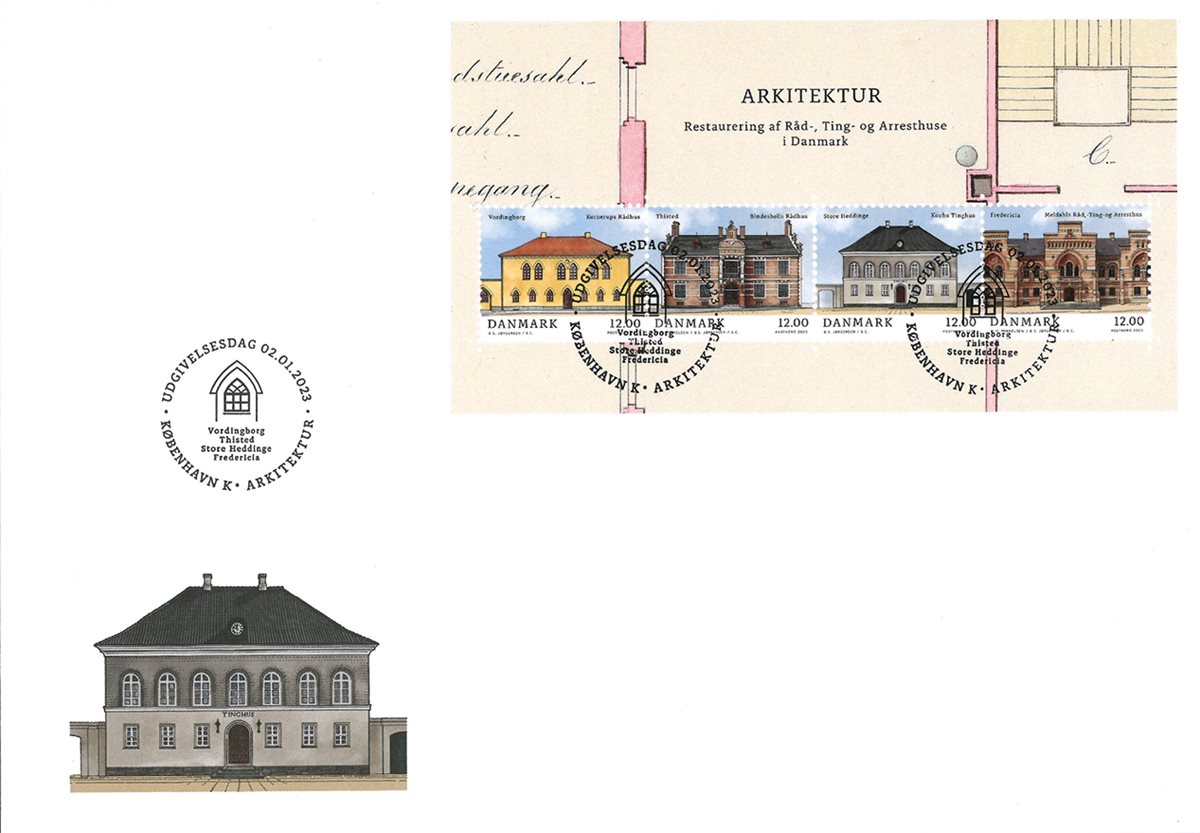
Jan. 2, 2023
Everyday Cycling — Cycling for Life
On January 2, 2023, Denmark’s branch of Postnoord issued a booklet containing two horizontal se-tenant strips of five self-adhesive stamps on the theme of “Everyday Cycling — Cycling for Life. Designed by Maria Tran, the 12-krone stamps have die-cut perforations and were printed using offset lithography. According to Nordfrim, which markets first day covers and other products for Postnoord,
“Maybe it’s because Denmark is flat as a pancake that so many of us like to take the bike. Maybe it’s because there are so many good bike lanes. Denmark is known as a nation of cyclists. Although the cargo bike is a popular means of transport for families with children, Danish children learn to cycle early on. The bike is used to and from work, but also as a means of work, as it is environmentally friendly. On the whole, the bike allows many – despite physical obstacles – to get out and get fresh air and good experiences in nature. Maria Tran has illustrated the small, cozy story you see on the stamps.”
Cycling is the use of cycles for transport, recreation, exercise or sport. People engaged in cycling are referred to as “cyclists”, “bicyclists”, or “bikers”. Apart from two-wheeled bicycles, “cycling” also includes the riding of unicycles, tricycles, quadricycles, recumbent and similar human-powered vehicles (HPVs).

Bicycles were introduced in the 19th century and now number approximately one billion worldwide. They are the principal means of transportation in many parts of the world, especially in densely populated European cities. Cycling is widely regarded as an effective and efficient mode of transportation optimal for short to moderate distances. Bicycles provide numerous possible benefits in comparison with motor vehicles, including the sustained physical exercise involved in cycling, easier parking, increased maneuverability, and access to roads, bike paths and rural trails. Cycling also offers a reduced consumption of fossil fuels, less air and noise pollution, reduced greenhouse gas emissions, and greatly reduced traffic congestion. These have a lower financial cost for users as well as for society at large (negligible damage to roads, less road area required). By fitting bicycle racks on the front of buses, transit agencies can significantly increase the areas they can serve.
In addition, cycling provides a variety of health benefits and reduces the risk of cancers, heart disease, and diabetes that are prevalent in sedentary lifestyles. Cycling on stationary bikes have also been used as part of rehabilitation for lower limb injuries, particularly after hip surgery. Individuals who cycle regularly have also reported mental health improvements, including less perceived stress and better vitality.
Among the disadvantages of cycling are the requirement of bicycles (excepting tricycles or quadricycles) for the rider to have certain level of basic skill in order to remain upright, the reduced protection in crashes in comparison to motor vehicles, often longer travel time (except in densely populated areas), vulnerability to weather conditions, difficulty in transporting passengers, and the fact that a basic level of fitness is required for cycling moderate to long distances.
Today, over 50 percent of the human population knows how to ride a bike.


Five designs in a self-adhesive booklet pane of ten stamps were issued by Postnoord Denmark on the topic of Needlework. The 36-krone stamps depict Needlework Customizing, Freehand Embroidery, Knitting, Crochet, and Sewing. The stamps were designed by Ella Clausen and printed using offset lithography with die-cut perforations. Nordfrim states:
“Needle and thread go a long way. Through the handmade product, there is ample opportunity to recycle discarded textiles and thereby include the environment and sustainability in the work process. The stamps show five categories in needlework that are trending right now, customizing (second word for upcycling or recycling), freehand embroidery, knitting, crocheting and sewing. The pieces shown are made by five skilled craftsmen: Annette Ørts Hansen, Karen Marie Dehn, Mette Wendelboe Okkels, Jeanette Bøgelund Bentzen and I Tråd Med Verden. You can follow them all on Instagram – and be inspired to get started yourself.”
Needlework is decorative sewing and textile arts handicrafts. Anything that uses a needle for construction can be called needlework. Needlework may include related textile crafts such as crochet, worked with a hook, or tatting, worked with a shuttle. Similar abilities often transfer well between different varieties of needlework, such as fine motor skill and knowledge of textile fibers. Some of the same tools may be used in several different varieties of needlework.
According to the Ladies’ Needlework Penny Magazine:
“There are many women who persuade themselves that the occupations particularly allotted to their sex are extremely frivolous; but it is one of the common errors of a depraved taste to confound simplicity with frivolity. The use of the needle is simple, but not frivolous.“

Needlework was an important fact of women’s identity during the Victorian age, including embroidery, netting, knitting, crochet, and Berlin wool work. A growing middle class had more leisure time than ever before; printed materials offered homemakers thousands of patterns. Women were still limited to roles in the household, and under the standards of the time a woman working on needle work while entertaining the parlor was considered beautiful. According to one publication from 1843: “Never is beauty and feminine grace so attractive as, when engaged in the honorable discharge of household duties, and domestic cares.”
Fancy work was distinguished from plain sewing and it was a mark of a prosperous and well-managed home to display handmade needlework. While plain sewing was often handed over to servants, even in middle class households, fancy work would often be done while entertaining guests, in the afternoons, evenings, or on Sundays. The types of goods that could be decorated with needlework techniques was limited only be the imagination: knitted boots, embroidered book covers, footstools, lampshades, sofa cushions, fans and on and on.

Jan. 2, 2023
Architecture
Bertil Skov Jørgensen was the designer of the miniature sheet containing four 12-krone Architecture stamps on ordinary gummed paper. The stamps depict Kornerup’s Town Hall in Vordingborg, Bindesbøll’s Town Hall in Thisted, Koch’s Courthouse in Store Heddinge, and Meldahl’s Town Hall, Court and Arrest House in Fredericia.
Dutch architecture has played an important role in the international discourse on architecture in three eras. The first of these was during the 17th century, when the Dutch empire was at the height of its power. The second was in the first half of the 20th century, during development of modernism. The third is not concluded and involves many contemporary Dutch architects who are achieving global prestige.
The Dutch Golden Age roughly spanned the 17th century. Due to the thriving economy, cities expanded greatly. New town halls and storehouses were built, and many new canals were dug out in and around various cities such as Delft, Leiden and Amsterdam for defense and transport purposes. Many wealthy merchants had a new houses built along these canals. These houses were generally very narrow and had ornamented façades that befitted their new status. In the countryside, new country houses were built, though not in the same numbers.
Of Italian Renaissance architecture, primarily visual characteristics such as pillars, pilasters, pediments and rustication were adopted, since many Dutch architects were unable to read the theoretical substantiation, which was often written down in Italian or Latin. Horizontal lines were emphasized, contrasting with the vertical emphasis of Gothic architecture. For instance, light-colored bands were embedded into facades to emphasize this horizontal character. Another common application in Dutch Renaissance architecture, particularly in Amsterdam, was the stepped gable, which was meant to hide the diagonal lines of the gable behind the straight lines of the façade.
The architecture of the first republic in Northern Europe was marked by sobriety and restraint, and was meant to reflect democratic values by quoting extensively from classical antiquity. It found its impetus in the designs of Hendrick de Keyser, who was instrumental in establishing a Venetian-influenced style into early 17th-century architecture through new buildings like the Noorderkerk (“Northern church”, 1620–1623) and Westerkerk (“Western church”, 1620–1631) in Amsterdam. In general, architecture in the Low Countries, both in the Counter-Reformation-influenced south and Protestant-dominated north, remained strongly invested in northern Italian Renaissance and Mannerist forms that predated the Roman High Baroque style of Borromini and Bernini. Instead, the more austere form practiced in the Dutch Republic was well suited to major building patterns: palaces for the House of Orange and new civic buildings, uninfluenced by the Counter-Reformation style that made some headway in Antwerp.

The major exponents of the mid-17th century, Jacob van Campen and Pieter Post, adopted de Keyser’s forms for such eclectic elements as giant-order pilasters, gable roofs, central pediments, and vigorous steeples. Brought together in a coherent combination, these stylistic developments anticipated Wren’s Classicism. The most ambitious constructions of the period included the seats of self-government in Amsterdam (1646) and Maastricht (1658), designed by Campen and Post, respectively. On the other hand, the residences of the House of Orange are closer to a typical burgher mansion than to a royal palace. Two of these, Huis ten Bosch and Mauritshuis, are symmetrical blocks with large windows, stripped of ostentatious Baroque flourishes. The same austerely geometrical effect is achieved without great cost or pretentious effects at the stadholder’s summer residence of Het Loo.
Another of the designs used by the Dutch was the use of warm colors such as red or dark orange. They also were roughly textured and had tended to be darkened due to the rough texturing. The use of architectural symmetrical balance was part of their habits as well.
During the 20th century, Dutch architects like Berlage, Van Doesburg, Van Eesteren, Rietveld, Oud and Van der Vlugt played a leading role in the development of modern architecture. Out of the early 20th century Rationalist architecture of Berlage, architect of the Beurs van Berlage, separate groups developed during the 1920s, each with their own view on which direction modern architecture should take. Expressionist architects like Michel de Klerk and Piet Kramer were associated with Amsterdam. Another group consisted of more functionalist architects (Nieuwe Zakelijkheid or Nieuwe Bouwen), such as Mart Stam, Leendert van der Vlugt, and Johannes Duiker, who had good ties with the international modernist group CIAM. A third group came out of the De Stijl movement, among them J.J.P. Oud and Gerrit Rietveld. Both architects later built in a functionalist style.
A 1918 reaction to Dutch functionalist architecture was the Traditionalist School, which lasted until well after 1945.






Leave a comment